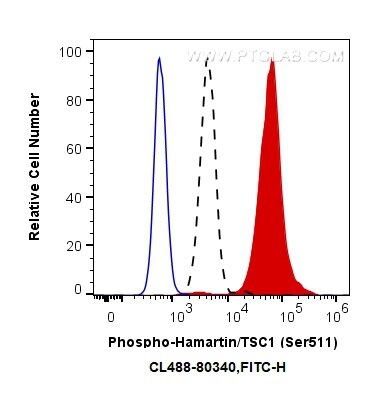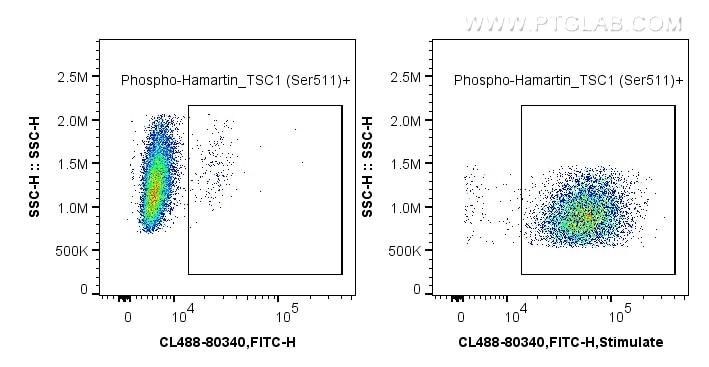Phospho-Hamartin/TSC1 (Ser511) Rekombinanter Antikörper
Phospho-Hamartin/TSC1 (Ser511) Rekombinant Antikörper für FC (Intra)
Wirt / Isotyp
Kaninchen / IgG
Getestete Reaktivität
human, Maus
Anwendung
FC (Intra)
Konjugation
CoraLite® Plus 488 Fluorescent Dye
CloneNo.
3N6
Kat-Nr. : CL488-80340
Synonyme
Galerie der Validierungsdaten
Geprüfte Anwendungen
| Erfolgreiche Detektion in FC | Mit Calyculin A behandelte HeLa-Zellen |
Empfohlene Verdünnung
| Anwendung | Verdünnung |
|---|---|
| Durchflusszytometrie (FC) | FC : 0.25 ug per 10^6 cells in a 100 µl suspension |
| It is recommended that this reagent should be titrated in each testing system to obtain optimal results. | |
| Sample-dependent, check data in validation data gallery | |
Produktinformation
CL488-80340 bindet in FC (Intra) Phospho-Hamartin/TSC1 (Ser511) und zeigt Reaktivität mit human, Maus
| Getestete Reaktivität | human, Maus |
| Wirt / Isotyp | Kaninchen / IgG |
| Klonalität | Rekombinant |
| Typ | Antikörper |
| Immunogen | Peptid |
| Vollständiger Name | tuberous sclerosis 1 |
| Berechnetes Molekulargewicht | 130 kDa |
| Beobachtetes Molekulargewicht | 150 kDa |
| GenBank-Zugangsnummer | NM_000368 |
| Gene symbol | TSC1 |
| Gene ID (NCBI) | 7248 |
| Konjugation | CoraLite® Plus 488 Fluorescent Dye |
| Excitation/Emission maxima wavelengths | 493 nm / 522 nm |
| Form | Liquid |
| Reinigungsmethode | Protein-A-Reinigung |
| Lagerungspuffer | BS mit 50% Glyzerin, 0,05% Proclin300, 0,5% BSA, pH 7,3. |
| Lagerungsbedingungen | Bei -20°C lagern. Vor Licht schützen. Nach dem Versand ein Jahr stabil. Aliquotieren ist bei -20oC Lagerung nicht notwendig. 20ul Größen enthalten 0,1% BSA. |
Hintergrundinformationen
TSC1, also named as Hamartin, is a tumor suppressor gene syndrome whose manifestations can include seizures, mental retardation, autism, and tumors in the brain, retina, kidney, heart, and skin. The tuberous sclerosis 1 (TSC1)/TSC2 tumor suppressor complex serves as a repressor of the mTOR pathway, and disruption of TSC1/TSC2 complex function may contribute to tumorigenesis. TSC1 is phosphorylated by IKKb at Ser487 and Ser511 in vitro and in vivo, and phosphorylation at these sites enhances dissociation of the TSC1/TSC2 complex, which in turn induces mTOR activation. (PMID: 17693255). TSC1 is also threonine-phosphorylated at three sites (Thr417, Ser584, and Thr1047) in a reaction catalyzed by cyclin-dependent kinase 1 (CDK1) (PMID: 14551205).



